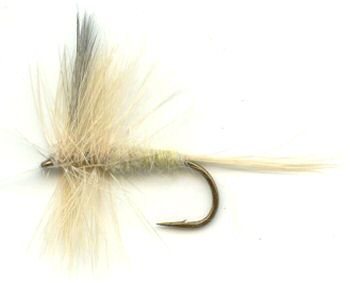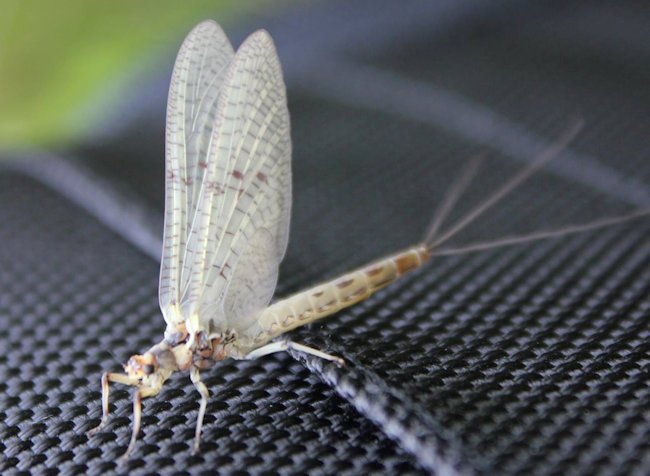The Pale Morning Dun Dry Fly PMD
The PMD is a small mayfly found in most western North American trout streams and other locations throughout the world. On most days during the emergence period you can practically set your watch by the start and stop times of the hatch.

DRY FLY PATTERNS. Hook size 12 14 16 18 20 24 - $US each
On some rivers the Pale Morning Dun hatch lasts for months. This gives the trout time to tune into this abundant food source at all the different stages; nymph, emerger, dun and spinner. There body size ranges from 6mm to 9mm in length which corresponds to size 14 to 18. Like other mayflies they get smaller as the season progresses. This phenomena lead to confusion in identification of species by the early angling entomologists, along with the even more confusing different body shades of the females and males which did not help classification. Body colors range from pale yellow olive, pale chartreuse to rusty orange.
Pale Morning Dun is a common term for different species of the insect family group called Ephemerella. It is hard to tell them apart without the help of a microscope. For the fly fisher it does not matter what sub species is hatching. In appearance, behavior and habitat they are so much alike. The PMD nymphs are crawlers. They live among rocks and debris feeding on vegetation. They have well developed legs that enable them to crawl along the bottom of the river without getting swept away. They stay hidden among the rocks and debris and are seldom available to the trout. They are not very good swimmers. If they do lose contact with the river bottom they can drift for long distances before sinking to the bottom again. They are very vulnerable if this happens. They have square shaped head and rectangular body. A Gold Ribbed Hairs Ear Nymph or Pheasant Tail Nymph is ideal as a PMD nymph imitation.

On rivers where the water surface is broken or there is a lot of fishing pressure, you may find the trout more cautious and feed exclusively on drifting nymphs ignoring anything on the surface. If you see drifting and flying duns but no rises this is what the fish are doing and you will need to change tactics from surface dry flies to nymph fishing. The best way to choose your nymph imitation is to collect a few samples of the natural insect from the river or stream bed and match the size and color. Remember to look at them up to the light to see their true color as seen by the fish. Trout normally attack their prey from below and will look at them against the light of the bright sky. Nymphs that look black in the hand turn out to be brown or olive when the light is behind them. When the nymph is mature it rises to the surface, where the nymphal shucks split open and the duns emerge and fly off onto nearby vegetation. Soft hackle wet flies are ideal for imitating the nymph moving up the column of water to the surface. Emerger flies like Klinkhammers, Shipman's buzzer or Suspender buzzers make good choices for PMD nymphs hatching.
The Pale Morning Dun sits on the water surface for a few seconds after hatching to enable the blood to pump up it's wings and for them to dry. The colder the weather the longer this takes. On windy days, gusts can topple over the drifting duns and drown them. If you cannot see any rises for surface floating duns during a hatch on windy days the fish are feasting sub surface on the unlucky sinking drowned duns as well as the emerging nymphs. Try using a partridge and Yellow Soft hackled spider wet fly, Gold Ribbed Hares Ear Wet fly, Blue Dun or Light Cahill wet fly to imitate drowned PMD's, depending on the local insects body color that can range from pale yellow, olive to tan. Wing color also varies throughout the world from pale gray to pale yellow. I often fish these wet flies on a dropper about 18 inches behind a PMD dry fly. The soft hackle or wet fly imitating the drowned dun often catches the fish when nothing else works.
If the drifting newly emerged PMDs have not been eaten by a fish during this vulnerable time, they fly off and hide on the surrounding vegetation. Within 24 hours the duns molt into spinners and and are ready to mate. Mating swarms are formed by the males to attract females. When a female flies into the swarm she mates with a male. The males fall onto the water spent and drown. The females return to the riverside vegetation for a short period whilst the eggs mature. When the eggs are ready the females fly out over the water, dip into the water, lay their eggs and then fall into the water spent. Try and scoop up a natural spinner floating dead in the water surface and match the body color with a parachute dry fly like a Greenwells, Tup's Indispensable or Gold Ribbed Hares Ear Parachute.
Fishing with flies has been around for a long time in the British Isles. During the English civil war, one of Cromwells soldiers, Col Robert Venables in 1662 is quoted as giving the following advice to fellow flyfishing enthusiast, "observe principally the belly of the fly, that colour the fly observes most, as being most in their eye." The same advice is very true today. Some angler-entomologists like to identify the exact subspecies of insect and tie an artificial fly that copies it exactly. In my experience this is not necessary. So long as you get the size of the fly and the body color correctly matching the natural insect is that your local trout are feeding on then a general pattern works as well as an exact copy. It is the underside of the fly that the trout observe the most. The pale morning dun fly pattern is a good choice for imitating many of the lighter colored flies that you will find on most water systems.
When trout observe a spent female spinner that has laid its eggs or a fallen male mayfly spinner, as it lies flat in the surface film, it sees the pale underside of the abdomen, two tales in the wings lying flat on the surface. It is more common for mayfly spinner falls to occur in the evening. Some falls occur at dusk or even later. During these periods of fishing exact color matching is less significant as the quality of light decreases.
The pale watery fly is very common throughout England and especially in chalk streams and limestone streams further north. I hardly ever see them in Scotland. I have not noticed them in Ireland. You will find dun hatches occurring from early May through to November, normally in the afternoon and early evening. The light colored fly called the Lesser Spurwing is very common throughout Britain and Ireland. It can be found on lakes, lochs, reservoirs and rivers. Dun hatches of the Lesser Spurwing start a little bit earlier than the pale watery dun, in April, but still go on until November. You will commonly find hatches happening in the afternoon at the beginning and the end of the season, but in the evening during late June, July and August. I have found the Greater Spurwing mayfly in Wales, Scotland and England. So far I have not come across it in Ireland. It seems to love limestone streams and chalk streams especially if they flow through rich farmland. The biggest hatches of the Greater Spurwing duns occur from late June to September in the late afternoon. Those fly fisherman that go home for an evening meal normally miss the pale evening dun hatches as they usually occur late in the evening and often after nightfall. The largest hatches occur in July August and early September. This fly is widespread in the rivers throughout the British Isles. All these flies have a similarity in appearance. I have found the pale morning dun flyfishing pattern works when any of these species are hatching.
The Pale Watery Dun (Baetis fuscatus) likes streams and rivers. The spinner is seldom seen in large swarms and often falls to the water earlier in the evening than others. But if the trout are being picky about what they take they often prefer a Pale Watery rather than other spinners. This fly can be used to represent of the light colored mayfly duns and spinners. Treat with floatant and fish on the surface. Leave the fly to drift with the current. Every now and then tug it over a short distance to mimic take-off or give it a twitch to represent the fly being caught in the surface film just before death.
Fishing the River Wye, which starts in the Welsh Cambrian hills and enters the River Seven near Chepstow, in winter needs leaded nymphs, shrimps and bugs to catch Grayling. Springtime fishing is dominated by large dark and medium olive hatches. Throughout the summer and autumn, pale water dun and blue winged olive mayflies appear daily. The pattern is often distinct with a late morning and afternoon Dun hatch followed by an evening spinner fall.
The Pale Evening Dun (Proclueon Pseudorufulum) is recorded all over Britain, but seems commonest in Ireland. It is also found in other parts of the world. It resembles the Pale Watery Dun with the exception that it does not have the Pale Watery Dun's additional hind legs. The nymph seems to like slow moving streams and rivers. A hook size 14 is ideal for this fly. A Gold Ribbed Hares Ear Shipman's Buzzer is a good emerger paten for this insect.
CUSTOMER'S COMMENTS
Fly fishing with your small hook Pale Watery Dun dry fly can be very productive when the river falls ‘flat’ in the early afternoon. Careful casting of a hook size 22 dry fly upstream in likely places, especially adjacent to weed-beds and under bushes, can persuade a surprising number of trout to forgo their afternoon nap to sip it quietly in. I have found a lot of sport by doing this in flat-clam stillwaters. These small flies are productive in early evening before the main hatch begins, but as most fish take them quietly, seeing the take is difficult once the light fades.
- Peter Fox, Chicago
FACEBOOK COMMENT
It is the beginning of July and the killer flies are PMD's on the Madison River Today - Bob Emms


Fly Fishing books





